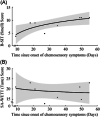Objective screening for olfactory and gustatory dysfunction during the COVID-19 pandemic: a prospective study in healthcare workers using self-administered testing
- PMID: 33614178
- PMCID: PMC7879131
- DOI: 10.1016/j.wjorl.2021.02.001
Objective screening for olfactory and gustatory dysfunction during the COVID-19 pandemic: a prospective study in healthcare workers using self-administered testing
Abstract
Background: Smell and taste loss are highly prevalent symptoms in coronavirus disease 2019 (COVID-19), although few studies have employed objective measures to quantify these symptoms, especially dysgeusia. Reports of unrecognized anosmia in COVID-19 patients suggests that self-reported measures are insufficient for capturing patients with chemosensory dysfunction.
Objectives: The purpose of this study was to quantify the impact of recent COVID-19 infection on chemosensory function and demonstrate the use of at-home objective smell and taste testing in an at-risk population of healthcare workers.
Methods: Two hundred and fifty healthcare workers were screened for possible loss of smell and taste using online surveys. Self-administered smell and taste tests were mailed to respondents meeting criteria for elevated risk of infection, and one-month follow-up surveys were completed.
Results: Among subjects with prior SARS-CoV-2 infection, 73% reported symptoms of olfactory and/or gustatory dysfunction. Self-reported smell and taste loss were both strong predictors of COVID-19 positivity. Subjects with evidence of recent SARS-CoV-2 infection (<45 days) had significantly lower olfactory scores but equivalent gustatory scores compared to other subjects. There was a time-dependent increase in smell scores but not in taste scores among subjects with prior infection and chemosensory symptoms. The overall infection rate was 4.4%, with 2.5% reported by PCR swab.
Conclusion: Healthcare workers with recent SARS-CoV-2 infection had reduced olfaction and normal gustation on self-administered objective testing compared to those without infection. Rates of infection and chemosensory symptoms in our cohort of healthcare workers reflect those of the general public.
Keywords: Anosmia; Brief Smell Identification Test; COVID-19; Chemosensory dysfunction; Dysgeusia; Gustation; Healthcare workers; Objective testing; Olfaction; Screening; University of Pennsylvania Smell Identification Test.
© 2021 Chinese Medical Association. Production and hosting by Elsevier B.V. on behalf of KeAi Communications Co., Ltd.
Conflict of interest statement
☐ The authors declare that they have no known competing financial interests or personal relationships that could have appeared to influence the work reported in this paper. ☒The authors declare the following financial interests/personal relationships which may be considered as potential competing interests:
Figures



Similar articles
-
Olfactory and gustatory dysfunctions as a clinical presentation of mild-to-moderate forms of the coronavirus disease (COVID-19): a multicenter European study.Eur Arch Otorhinolaryngol. 2020 Aug;277(8):2251-2261. doi: 10.1007/s00405-020-05965-1. Epub 2020 Apr 6. Eur Arch Otorhinolaryngol. 2020. PMID: 32253535 Free PMC article.
-
Olfactory and Gustatory Recovery Time Evaluation of COVID-19: A Systematic Review and Meta-Analysis.Acta Med Indones. 2025 Jan;57(1):18-43. Acta Med Indones. 2025. PMID: 40263685
-
COVID-19: Recovery from Chemosensory Dysfunction. A Multicentre study on Smell and Taste.Laryngoscope. 2021 May;131(5):1095-1100. doi: 10.1002/lary.29383. Epub 2021 Jan 15. Laryngoscope. 2021. PMID: 33404079
-
Recovery from olfactory and gustatory dysfunction following COVID-19 acquired during Omicron BA.1 wave in Italy.Am J Otolaryngol. 2023 Sep-Oct;44(5):103944. doi: 10.1016/j.amjoto.2023.103944. Epub 2023 Jun 8. Am J Otolaryngol. 2023. PMID: 37354725 Free PMC article.
-
Sudden onset, acute loss of taste and smell in coronavirus disease 2019 (COVID-19): a systematic review.Acta Odontol Scand. 2020 Aug;78(6):467-473. doi: 10.1080/00016357.2020.1787505. Epub 2020 Aug 7. Acta Odontol Scand. 2020. PMID: 32762282
Cited by
-
Performance of formal smell testing and symptom screening for identifying SARS-CoV-2 infection.PLoS One. 2022 Apr 12;17(4):e0266912. doi: 10.1371/journal.pone.0266912. eCollection 2022. PLoS One. 2022. PMID: 35413084 Free PMC article.
-
The taste of the pandemic-contemporary review on the current state of research on gustation in coronavirus disease 2019 (COVID-19).Int Forum Allergy Rhinol. 2022 Feb;12(2):210-216. doi: 10.1002/alr.22902. Epub 2021 Oct 26. Int Forum Allergy Rhinol. 2022. PMID: 34704387 Free PMC article. Review.
-
Changes in smell and taste perception related to COVID-19 infection: a case-control study.Sci Rep. 2022 May 17;12(1):8192. doi: 10.1038/s41598-022-11864-8. Sci Rep. 2022. PMID: 35581235 Free PMC article.
-
Long-Term Taste and Smell Outcomes After COVID-19.JAMA Netw Open. 2024 Apr 1;7(4):e247818. doi: 10.1001/jamanetworkopen.2024.7818. JAMA Netw Open. 2024. PMID: 38652477 Free PMC article.
-
Chemosensory Dysfunction in Long-Term COVID-19 Assessed by Self-Reported and Direct Psychophysical Methods.Life (Basel). 2022 Sep 25;12(10):1487. doi: 10.3390/life12101487. Life (Basel). 2022. PMID: 36294922 Free PMC article.
References
-
- Tong JY, Wong A, Zhu D, Fastenberg JH, Tham T. The prevalence of olfactory and gustatory dysfunction in COVID‐19 patients: a systematic review and meta‐analysis. Otolaryngol Head Neck Surg. 2020;163:3‐11. - PubMed
-
- Borsetto D, Hopkins C, Philips V, et al. Self‐reported alteration of sense of smell or taste in patients with COVID‐19: a systematic review and meta‐analysis on 3563 patients. Rhinology. 2020;58:430‐436. - PubMed
LinkOut - more resources
Full Text Sources
Other Literature Sources
Miscellaneous

